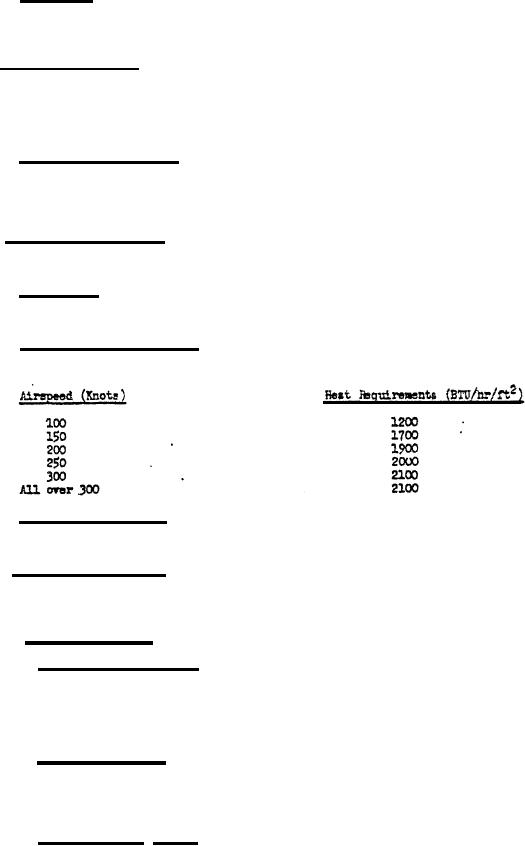
MIL-H-18325B (Aer)
Sun Shields - Sun shields shall be provided for overhead cabin transparencies when
3.7.2
required by the airlane detail specifications. Sun sheilds shall be readily movable, shall
be of the transparent infra-red reflecting type and shall reduce the transmission of incident
infra-red radiant energy at least 60 per cent.
3.8 Defogging, Defrosting - All transparent areas essential to the mission and operation of
the aircraft, including windshield, scanning and sighting stations astrodomes, camera windows,
etc., shall be completely defogged and defrosted during all operations and all conditions of
flight. For combat type aircraft, this includes rapid descent at limit dive speed. For carrier
based aircraft, this includes carrier circling and carrier landing operations. The system shall
Conform tO Specification MIL-T-5842.
3.8.2 Method of Accomplishment - Defogging-defrosting shall be accomplished by maintaining
the temperature of the interior surface of the transparency above the dew point by at least
5°F. For purposes of calculation, the relative humidity of the surrounding air shall be assumed
to be 100 per cent at any altitude up to ceiling of the airplane and at any selected temperature
within the cockpit. Outside air temperature shall be assumed constant at -65°F.
3.9 Defogging and Anti-Icing - Where both defogging and thermal anti-icing are specified, the
heating system shall be capable of simultaneously preventing the formation of ice on the exterior
of the windshield, and fog and frost on the interior surfaces.
Heat Sources - Heat for defogging and anti-icing may be applied connectively by the flow
3.9.1
of clean air, by electrically conductive coatings, or by infra-red radiations applied to the
transparencies.
Anti-Icing Heat Requirement - For aircraft operating at the airspace indicated be-
3.9.2
the heating system shall be capable of supplying sufficient heat to the exterior surface of
windshield to meet the requirements for anti-icing given on a curve defined by the following table
Temperature Regulation - In order to prevent overheating of equipment or compartments,
3.9.3
automatic regulation to limit the temperature to the values specified hearin shall be provided.
These controls shall be of the "fail-safe" type.
3.10 Heating and Ventilating - Heating and ventilating provisions as indicated for the
following equipment shall be provided unless otherwise specified in this airplane detailed specifi-
Cation. If the cabin heating system is to be used wholly or in part to provide equipment heating,
it shall have sufficient thermal capacity to meet all tne simultaneous requirements of the system
3.10.1
Installed Equipment
3.10.1.1 Flexible Weapons Systems - Inhabited turrets shall be maintained at minimum tempera-
ture of +35°F by means of hot air or other approved methods in order to preclude hindering normal
operations by turrent occupant due to excessive cold. Heating for uninhabited turrets, if required,
shall be as specified in the applicable equipment or airplane detail specification. For additional
information concerning general installation requirements of flexible weapons systems, see
Specification MIL-I-8673.
Gun Gas Elimination - Adequate ventilation shall be provided to prevent excessive
3.10.1.2
accumulations of gun gases, and suitable sealing provisions shall be made to prevent contamination
of adjacent compartments in excess of the limits given in Section 3.6 of this specification. For
Fixed gun installations, see Specification MIL-I-8670(Aer) and for flexible weapons systems, see
Specification MIL-I-8673.
Armament Control Systems 0 - Armament control systems are designed to operate satisfactorily
3.10.1.3
in temperature ranges of -700F to +160 F and the humidity ranges encountered within this teperature
5
For Parts Inquires submit RFQ to Parts Hangar, Inc.
© Copyright 2015 Integrated Publishing, Inc.
A Service Disabled Veteran Owned Small Business